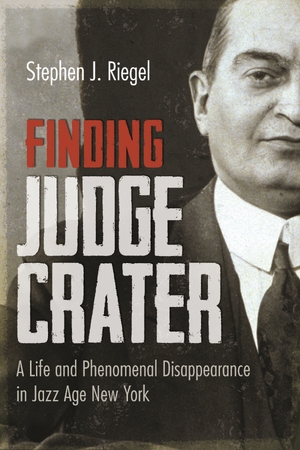"Crater was a character out of a Jazz Age story F. Scott Fitzgerald never wrote. . . . Now the judge and his flamboyant era have been resurrected in Finding Judge Crater. . . . It’s a good yarn and the author even provides his own credible solution to the mystery at the end."—The Wall Street Journal
"Riegel immerses readers in the riotous nightlife of 1920s Manhattan, where the elite rubbed shoulders with the underworld in a mutual pursuit of Prohibition-restricted booze.... Finding Judge Crater presents a compelling and plausible solution to this enduring mystery."—Ellery Queen Mystery Magazine
"Stephen Riegel tackles one of the country’s most enduring and perplexing missing-person cases. His fascinating blend of history and mystery is a story to savor, enjoy and revisit."—Peter Quinn, author of The Man Who Never Returned
"Finding Judge Crater offers true crime fans a new take on an old mystery; for students and educators, the text provides a compelling base toexplore the excesses of the Jazz Age and the realities of the Great Depression in
Manhattan."—New York History"Riegel has put to good use his experience as a litigator and former federal prosecutor, as well as his history degree from Princeton and JD from Stanford Law School to paint a colorful picture of New York poiltics in the Jazz Age."—Washington Lawyer
"An intriguing and substantial chronicle of the once-notorious disappearance of Judge Joseph F. Crater in 1930."—Burton Peretti, author of Nightclub City: Politics and Amusement in Manhattan
"With his deep knowledge of New York politics and its judicial system, Stephen Riegel explains how Judge Crater rose to prominence, and what led to his disappearance."—Terry Golway, author of Machine Made: Tammany Hall and the Creation of Modern American Politics
"The raucous world of Jazz Age Manhattan rushes forth from the pages of this enjoyable narrative—from Tammany politicos and Broadway gadabouts to good government reformers and desperate entrepreneurs, Riegel brings to life a colorful cast of characters and momentous episodes that make this story unforgettable."—Robert Chiles, author of The Revolution of '28 and co-editor of New York History
"So vividly does Riegel bring this book to life that I had the feeling of turning pages, blank for a moment, before being populated with people and places that I could actually see. Riegel instinctively travels backwards and forwards in time around the disappearance, until the decadent Roaring Twenties, the Jazz Age, showgirls, gangsters and politicians rise from the pages, constructed like the infrastructure of early NYC itself."—Jessica Reed, A Time and A Place Magazine
Description
On the night of August 6, 1930, Joseph Force Crater, a newly appointed judge and prominent figure in many circles of Manhattan, hailed a taxi in the heart of Broadway and vanished into thin air. Despite a decades-long international manhunt led by the New York Police Department’s esteemed Missing Persons Bureau, the reason for Crater’s disappearance remains a confounding mystery. In the early months of the investigation, evidence implicated and imperiled New York’s top officials, including then-Governor Franklin D. Roosevelt and Mayor Jimmy Walker, as well as the city’s Tammany Hall political machine, lawyers and judges, and a theater mogul.
Drawing on new sources, including NYPD case files and court records, and overlooked evidence discovered years later, Riegel pieces together the puzzle of what likely happened to Joseph Crater and why. To uncover the mystery, he delves into Crater’s ascension into the scintillating and corrupt world of Manhattan in the Roaring Twenties and Jazz Age. In turn, the story of the judge’s vanishing amid the Great Depression unfolds as a harbinger of the disappearance of his lost metropolis and its transformation into modern-day New York City.
About the Author
Stephen J. Riegel is a practicing litigator and former federal prosecutor in New York City who appears in some of the same courts Crater did. He also has degrees in American history from Princeton University and Stanford University. He has published articles on legal history.
January 2022




